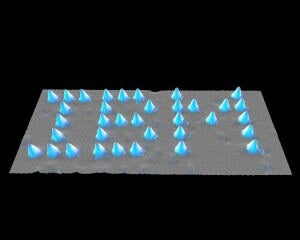
It was twenty years ago when Don Eigler, a fellow at IBM, made history by moving individual atoms for the first time. Like any good employee he used his new found ability to do something productive for the company: spell out ‘IBM’ using thirty five xenon atoms. With that microscopic marketing ploy began a new era of research into nanotechnology that continues today. Check out IBM’s anniversary video after the break.
IBM had long been at the forefront of atomic research, building the first Scanning Tunneling Microscope in 1981. Eigler was using a STM in 1989 when he made the discovery he could manipulate individual atoms with the instrument. Recently, IBM continued to astound the world by creating nanoscale MRI, and imaging a molecule for the first time. The ability to move atoms and molecules, and observe what you are doing, is a revolutionary technology that opens the door to molecular machines – devices built of just a handful of atoms.
Those familiar with biology know that our cells already possess several structures that could be called molecular machines. In that way, nanotechnology and biotechnology are working towards one another. The successes at IBM suggest that the future of atomic scale manipulation may involve building interesting new substances that might fit into our lives at the cellular level.
Even if they stay outside ourselves, materials built one atom at a time are going to be amazing. Programmable matter, a substance that can rearrange itself to become anything you need, will become a reality when computer chips and machines can be built on a nanoscale. Quantum computing, superconductive wire, and carbon fibers stronger than steel – the next generation of technology was started with Eigler’s experiments.
It has taken 20 years to go from moving individual atoms to building artificial organelles, using carbon nanotubes in biosensors, or any of the hundreds of other current applications of nanotechnology. One wonders what we will see in the next twenty years. An IBM logo in your DNA?
[photo credit: IBM]



